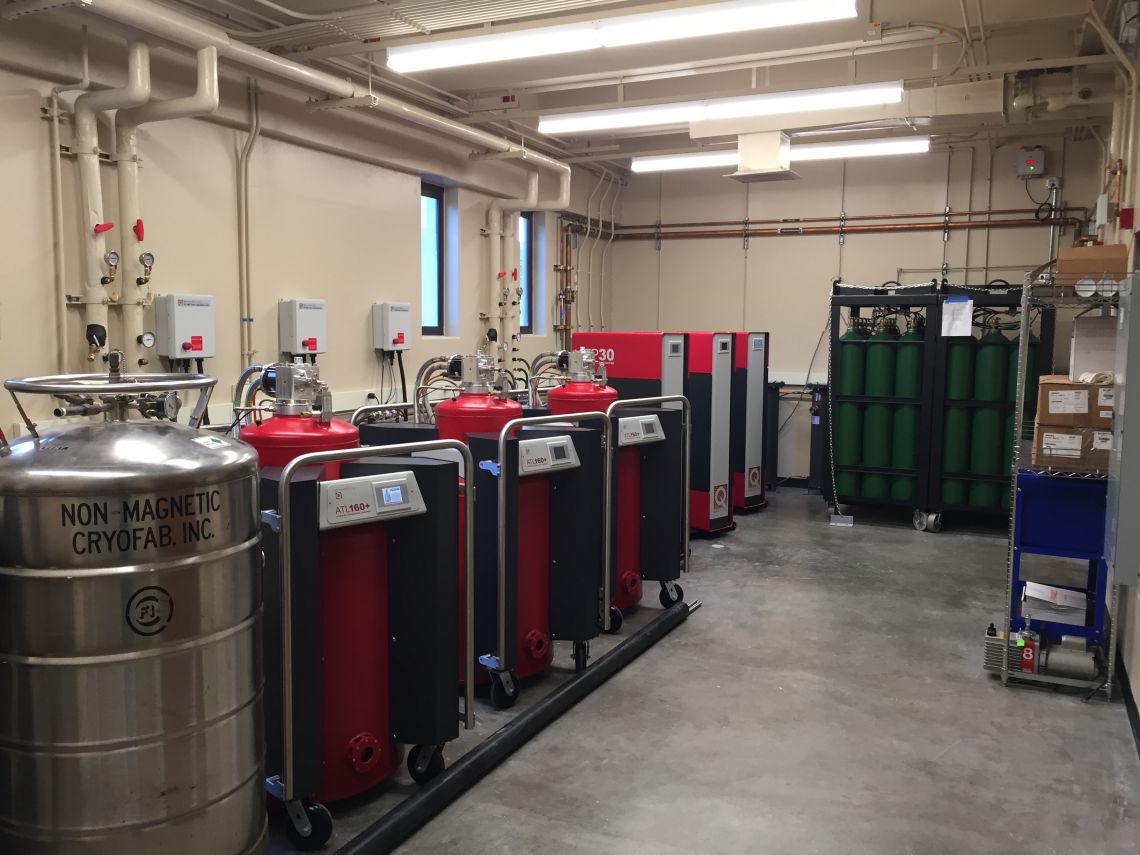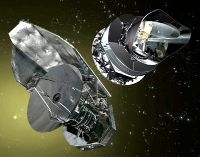
For a graduate student, access to cutting edge research facilities and instrumentation offers the very real possibility of probing new physics. This new physics knows no boundaries, and the possibilities are limited only by the innovative questions we ask. The universe itself is now a laboratory for the exploration of fundamental physics: recent discoveries have strengthened the connections between fundamental symmetries, the basic forces of nature, and the structure and evolution of the universe. New measurements will test the foundations of cosmology and help determine the nature of dark matter and dark energy, which make up 95 percent of the mass-energy of the universe. Answers to such basic questions about the fundamental properties of matter require next-generation facilities and bold new experimental and theoretical approaches using techniques of complex systems, condensed matter, biophysics, astrophysics, particle, nuclear, and gravitational physics.
Facilities serve entire communities, from large groups to single investigators. Even the power of smaller instrumentation has grown to the point where single investigators working together with their students can change how we think about the world. The promise of advanced instrumentation can be best understood by looking at current explorations.
Intense synchrotron light and neutron facilities advance our understanding of high-Tc materials and the molecular structure of biological systems. New instruments have provided the means by which researchers have been able to explore regimes of time and space unimagined just a few years ago. Higher energy and intensity accelerators and new astrophysical observatories are planned that will probe nature at extremes ranging from 10-18 cm to 10+28 cm. Femtosecond lasers now examine the making and breaking of specific chemical bonds; and new microscopies, such as atomic force microscopes, are opening up the viewing of individual atoms and molecules.
At UC Davis our students have access to a wide range of physics research facilities that we list below by discipline.
For more information about research opportunities, please see Research Areas.
Particle, Nuclear and Heavy Ion Physics
High Energy Physics at Colliders
- Tevatron at Fermilab - Illinois
- Large Hadron Collider at CERN - Geneva
Profs. Maxwell Chertok, John Conway, Robin Erbacher, Mani Tripathi, and Profs. Emeritus Richard Lander and Dave Pellett work at colliders to study fundamental interactions in particle physics. A dozen or so postdoctoral scholars and graduate students are resident at these labs, where they operate detectors and carry out data analysis. The group participates in the following experiments:
The heavy ion physics group of Profs. Daniel Cebra and Manuel Calderon also utilize the CMS experiment, while they continue to work at Brookhaven National Lab:
Particle Physics at Non-Accelerator Sites
- Double Chooz reactors - France
- The Sanford Lab in Lead - South Dakota
Prof. Robert Svoboda is involved in measuring neutrino oscillations with the Double Chooz experiment which detects neutrino emissions from two large nuclear reactors. He and Prof. Mani Tripathi are founding members of the LUX dark matter search experiment located at the now defunct Homestake mine, which has an experimental hall at a depth of nearly one mile.
Detector R&D for Particle Physics
- The McClellan Nuclear Research Center - UC Davis
- The Crocker Nuclear Laboratory - UC Davis
- Facility for Interconnect Technology - UC Davis
These facilities at UC Davis are very important for detector R&D. The 2 MW TRIGA reactor at MNRC is used for neutron activation analysis in order to radio-assay materials to be usd in low background experiments. The 63 MeV cyclotron at Crocker has been used extensively to study radiation damage effects on silicon detectors and VLSI electronics that are used in collider experiments. The facility for interconnect technology is a recent and unique addition, which is used to develop bump-bonding techniques for detector assembly.
Condensed Matter Physics

The Helium Recovery Facility
The helium recovery facility, located in the basement of the Physics Building, uses state-of-the-art technology to recover approximately 90% of the helium used for research by the Physics & Astronomy Department. Helium is a non-renewable resource that has become increasingly expensive and difficult to acquire, but is absolutely vital to many of the cutting-edge experiments conducted in the department. The new facility houses three separate liquefiers that can each produce up to 30 L/day. Boil-off helium gas from cryostats located in laboratories on the second and basement floors is collected in a large inflatable bag, and then compressed into storage cylinders. A series of purifiers removes unwanted gases (such as nitrogen and oxygen contaminants) prior to liquefaction. Each liquefier can be separately disconnected from the recovery system and transported to the various laboratories to transfer the liquid helium into cryostats. The system was installed in partnership with Quantum Design, and can operate nearly autonomously.
This facility not only advances green technology, but will save millions of dollars in the long run and insulate the department from wild price fluctuations and uncertainty of a limited supply.
Advanced Photon Source (APS) synchrotron at Argonne National Laboratory
Group members of Profs. Warren Pickett and Richard Scaletter use beam time at the AP to probe phase transitions at high pressure (up to a megabar) in crystalline materials. Examples include identifying the volume-collapse, "Mott" insulator-to-metal transition in the correlated insulator MnO, and identifying structural and vibrational changes in novel magnets and in low-Z compounds that are potential high temperature superconductors.
Molecular Foundry, Berkeley Lab
Prof. Dong Yu's group uses the user facilities at the Molecular Foundry to fabricate and characterize devices incorporating single colloidal PbSe nanowires with sub-10nm diameters. These nanodevices provide ideal platforms for investigating quantum confinement effect and charge transport in pseudo one dimensional semiconductors.
SOLEIL Synchrotron in Gif-sur-Yvette, France
At this facility, Prof. Shirley Chiang collaborates with Prof. Patrick Soukiassian, Université de Paris-Sud/Orsay and CEA/Saclay, to make measurements on graphene using soft x-ray photoemission and infrared beamlines.

Nano-synthesis and Characterization Facilities
Prof. Kai Liuâ's group uses a variety of facilities for their study of nanostructured materials. Topics include perpendicular anisotropy, spin-transfer torque, magnetic vortices, exchange bias, magnetization reversal and hysteresis, half metals, and novel x-ray sources. His group has state-of-the-art synthesis capabilities using UHV magnetron sputtering, evaporation, electrochemical deposition, and characterization capabilities using x-ray diffraction, vibrating sample magnetometry, alternating gradient magnetometry, magneto-optical Kerr effect, H-B looper, etc. In addition, the following user facilities are used:
- UC Davis Northern California Nanotechnology Center (NCNC) for nanofabrication
- Advanced Light Source (ALS), Lawrence Berkeley National Laboratory for x-ray spectroscopy and microscopy studies of magnetic nanostructures
- National Institute of Standards and Technology (NIST) for neutron scattering, microscopy and magnetic imaging
- Los Alamos Neutron Science Center (LANSCE), Los Alamos National Laboratory for neutron scattering experiments
- Lawrence Livermore National Laboratory for ion track lithography
Computing Facilities at Lawrence Livermore National Lab
Prof. Ching Fong uses vpna.llnl.gov to logon to the computing facilities at LLNL. Since 2002, he has been collaborating with researchers at LLNL for designing spintronic materials and understanding the physics governing their properties.
Astrophysics & Cosmology

Ground-Based Telescopes
- Keck Telescopes - Mauna Kea, Hawaii
- Cerro Tololo Inter-American Observatory - Chile
Many of our observational astronomy faculty use the twin Keck telescopes, among the world's largest optical and infrared telescopes. Studies involve a variety of astrophysics topics, including dark matter, dark energy, cosmic reionization, galaxies, galaxy clusters, and supernovae.
Prof. Tony Tyson is also organizing the next digital sky survey for which he is the director:
Space-Based Telescopes
- Hubble Space Telescope
- James Webb Space Telescope

Cosmic Microwave Background Observatories
The current generation of cosmic microwave background observatories are putting further pressure on the standard cosmological model, greatly improving our sensitivity to physical processes in the early Universe. Professor Lloyd Knox and members of his group have proprietary access to data from the Planck and Herschel satellites and from the South Pole Telescope.
Computing, Chaos, and Geophysics
Santa Fe Institute, Santa Fe, NM
Profs. James Crutchfield and John Rundle are External Professors at SFI.
Prof. Rundle works on understanding phase transitions in complex systems, and applies these models and ideas to understanding systems as diverse as earthquakes and financial markets.
Prof. Crutchfield is also a former Research Professor at the SFI, where he directed SFI's Programs on Complex Interactive Networks, Dynamics of Learning, Physics of Computation, and Evolutionary Dynamics.
Jet Propulsion Laboratory (JPL)
Prof. John Rundle is a Distinguished Visiting Scientist at the Jet Propulsion Laboratory, where he works on space-based methods for remote sensing of earth deformation associated with earthquakes.
Southern California Earthquake Center (SCEC)
Prof John Rundle also works with scientists from SCEC, which is an NSF-USGS center, to develop and test simulations and to explore methods for earthquake forecasting.
